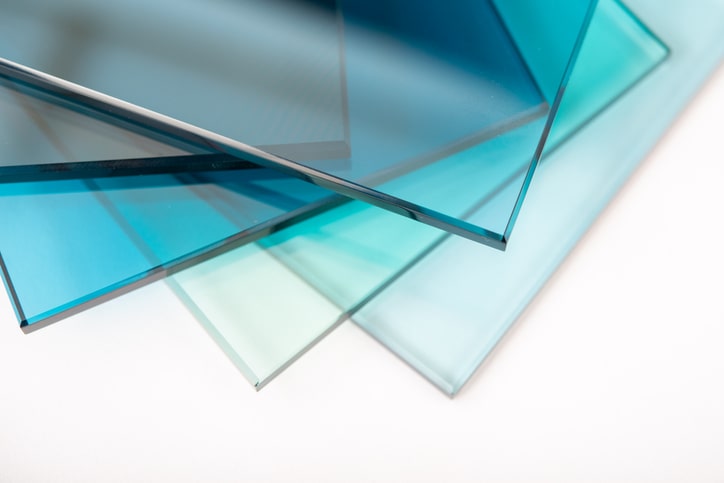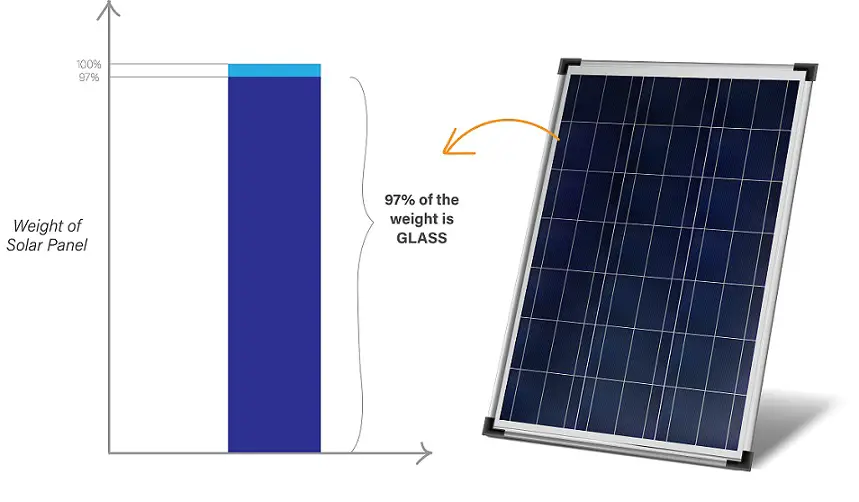Glass Used In Solar Panel Manufacturing

If you're looking to purchase new solar panels for your home or business then make sure to choose one that's right for your needs! Remember that not all glasses are created equal so do some research before making your decision.
We hope this article answers any questions you may have had about these different types of glasses.
The majority of commercial glasses used in solar panel manufacturing are oxide-based and have a similar chemical composition.
They can be categorized into three types, namely soda-lime glass, borosilicate glass, and lead crystal glass.
Soda-lime is the most commonly used type because it has a lower melting point than other types. Borosilicate is more expensive but offers better insulation properties than soda lime.
Lead crystal is also an option for high-temperature applications where thermal shock resistance is needed.
Solar technology can only be scalable if the manufacturing process follows the most cost-effective way possible while maintaining quality.
Therefore, manufacturers are continuously looking for new ways to produce solar panels while testing different materials for their production.
The manufacture of flat-glass manufacturing started in the 1950s. Alastair Pilkington invented “the Pilkington process” introducing a new way of manufacturing low-cost, high-quality flat glass sheets.
Using this process, molten glass is floated out on top of molten tin to create a homogeneous sheet with a smooth, flat surface in float-glass manufacture.
Float-glass manufacturing swiftly supplanted the older plate-glass technology, and it today accounts for 90% of all flat glass manufactured. Architectural glass (88% of the market) and automotive glass (11% of the market) are the two main markets for flat glass.
Currently, the demand for glass in the solar sector is currently less than 2% of the total market. However, this position is changing. It is expected that massive expansion in the solar industry will increase the market share of glass used in the glass market.
Why is glass extensively used in solar panel manufacturing?
Glass is the single largest component by mass in the majority of solar modules in production, and it accounts for roughly 97% of a module's weight. There are many good reasons why glass is used in solar panel production that we will discuss further.

The glass is used in solar power systems to protect components and offer structural strength to the module and encapsulate the cells. It is also used to manufacture mirrors used to concentrate sunlight in solar power systems.
| Reason | Explanation |
|---|---|
| Structural Strength | Glass provides strength and encapsulates solar cells. |
| Good Transmitter | Glass transmits sunlight without absorbing it, generating energy. |
| High Reflectance | Glass can reflect sunlight, making it useful for concentrating light. |
| Inherent Strength | Tempered soda-lime glass is strong and less prone to breakage. |
| Easy to Clean | Glass is easy to clean and can have self-cleaning properties, reducing maintenance. |
| Easy to Recycle | Glass can be recycled without hazardous byproducts. |
| Corrosion Resistance | Glass resists corrosion. |
| Lightweight Material | Glass is lightweight and doesn't add significant weight to modules. |
| Low Production Cost | Glass has a low production cost compared to other materials. |
Good transmitter
A “good transmitter” in solar applications refers to a material that allows light to pass through it without being absorbed or scattered.
Glass is a good transmitter of sunlight because it allows the light to pass through it to generate energy. Glass is also durable and can have anti-reflective coatings to increase the efficiency of solar cells.
High reflectance
Glass is also an excellent mirror in some applications because it can be made to have a reflective coating on one or both sides, making them useful for concentrating sunlight and other light sources.
The glass may need to be laminated and coated depending on the application. The three most common types of coatings applied are metal oxide (aluminum), silver nitrate, and gold chloride.
Inherent strength
Glass is strong enough not to break easily unless stress is applied in form of a shock which makes glass behave more brittle.
Most solar panel glasses are a type of tempered soda-lime glass that has been chemically treated to be stronger and less prone to breakage than regular window or drinking glasses.
Therefore, they can comfortably bear the stress created by strong storm events and snow loads.
Can be cleaned easily
Glass is easy to clean compared to most other materials. Cleaning glass doesn't require any special material and all you need is soap and water.
Since the glass surface is smooth, it's easy to clean any dirt or dust that gets stuck on its surface. Self–cleaning characteristics of a particular glass would aid in lowering maintenance expenses.
Easy to recycle
It is also easy to recycle, and it does not produce any hazardous byproducts when heated.
Once a solar panel completes its useful life, the glass is broken down into small pieces and heated to a temperature of 1000 degrees Celsius.
The resulting powder can be used in other products, such as fiberglass insulation for buildings or flat panel displays on TVs, computers, and cell phones.
It doesn't corrode easily
Glass is not a corrosion-proof material but it does not corrode easily. Water, which we perceive to be quite safe, is the chemical that is most destructive to glass.
Water erodes the glass's alkali components (sodium and potassium), creating tiny degradation.
Because this process takes time, washing your glasses in water is safe. The glass's composition is also an important component. Some glasses are far more stable in composition than others.
It is a lightweight material
Glass is a relatively lightweight material that makes it ideal for use in solar installations. A square meter of typical 4mm thick glass will weigh only 10kg which is not really bad.
Glasses have been manufactured in various thicknesses with the most common being 0.12 inches or less, so they do not add significantly to overall module weight.
It is a cheap material
Glass has a low production cost when compared to other materials which are typically more expensive (ie: Aluminum).
To manufacture glass the only raw materials required are sand and soda ash, and the process of melting and shaping glass is very straightforward and doesn't require multiple types of machinery to work on the material.
Types of PV Glasses according to used manufacturing technique
There are three types of flat glass still produced in any volume are float glass, rolled glass, and or drawn glass.
Of these three, 90% is made up of Float Glass which offers the best quality at the lowest cost on a large scale.
Because it cannot be manufactured with totally flat surfaces, rolled glass is utilized to make patterned and wired glass. It is made by passing softened glass between two rollers, and at least one is patterned.
Patterned glass (also known as figured glass) is occasionally used for crystalline silicon module cover glass. A shallow pattern on the glass diffuses the reflection of the module's front surface, improving the appearance.
Deeper patterns reduce reflection from the module's front surface, but they can also act as a trap for water and grime.
Drawn glass, in which molten glass is drawn through rollers, is an older technique that is being phased out in favor of the float process for large-scale manufacturing, but there are still some functioning factories, most notably in China.
Most flat glass is soda-lime glass, which is made up of silica, sodium oxide, and calcium oxide at a minimum.
However, most flat glass also contains oxides of magnesium, titanium, iron, potassium, and aluminum.
Because the softness point of silicon dioxide is 1500–1670 °C and melting silicon dioxide to generate flat sheets is highly expensive, soda-lime glass is manufactured.
The softening point is reduced to 550–750 °C by adding sodium oxide. However, because this renders the glass water-soluble, other elements, such as calcium oxide, are added to offer chemical resistance.
Although pure silicon dioxide can be used to make glass for specialist purposes, the cost is too high for large-scale use.
A few types of glass that are not as prevalent as soda-lime glass may offer certain advantages for solar modules. Low iron glass is one type.
The low iron glass comes in a variety of grades, with iron content as low as 100 ppm (standard soda–lime is roughly 1000 ppm).
Glass with less iron oxide offers greater sunlight transmission, resulting in more efficient solar cells. Solar transmission for soda-lime glass is approximately 85%; solar transmission for low-iron glass can exceed 91 percent.
Producing such glasses costs more than normal soda-lime glass, and for most uses, the extra expense is not justified. However, for the solar sector, the enhanced transmission may be worthwhile at a slightly higher cost.
There are other glasses with low or no alkali content. The alkali elements in soda-lime glass (sodium, calcium, potassium, and magnesium) can seep out of the glass and impact thin-film solar cells (especially under thermal load or applied voltage).
Because boro-silicates and fused quartz contain little or no alkali elements, they are frequently employed in laboratory glassware.
Because they must be treated at extreme temps than soda-lime glass (the softening point of borosilicate glass is 820 °C) and are not mass-produced using the float process, their cost is prohibitively high for many purposes.
The float-glass process is the most common way of producing flat glass. After the raw components have been mixed in the batch house, they are delivered into the furnace and melted at 1550 °C. The molten glass then flows onto the top of a bath of molten tin at 1050 °C.
The gas in the bath is a mixture of nitrogen and hydrogen, which prevents the tin from oxidizing. Because tin is denser than glass, it spreads out on top of the tin, creating a smooth, level surface.
Some tin combines into the surface of the glass in touch with the bath; this side of the glass, as opposed to the airside, is referred to as the tin side.
The glass is then placed in the annealing lehr, a tubular oven with a temperature gradient, where it is progressively cooled to 40 °C to prevent cracking.
It is also feasible to apply a coating (anti-reflection, TCO, etc.) during or after the tin bath using chemical vapor deposition.
Lastly, the glass is inspected for flaws, coated with Lucite separating medium to avoid scratches during packing and shipping and cut to size.




